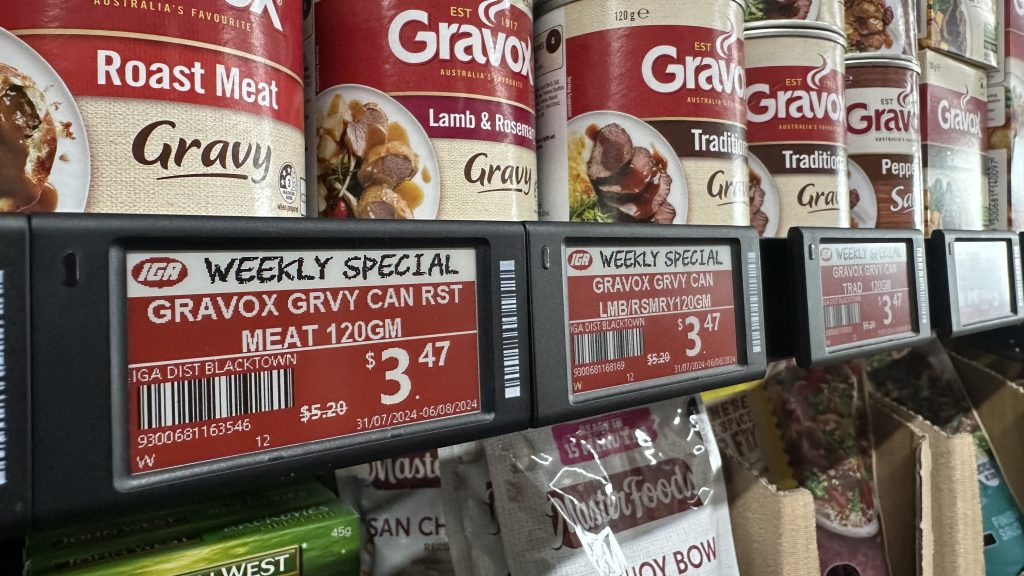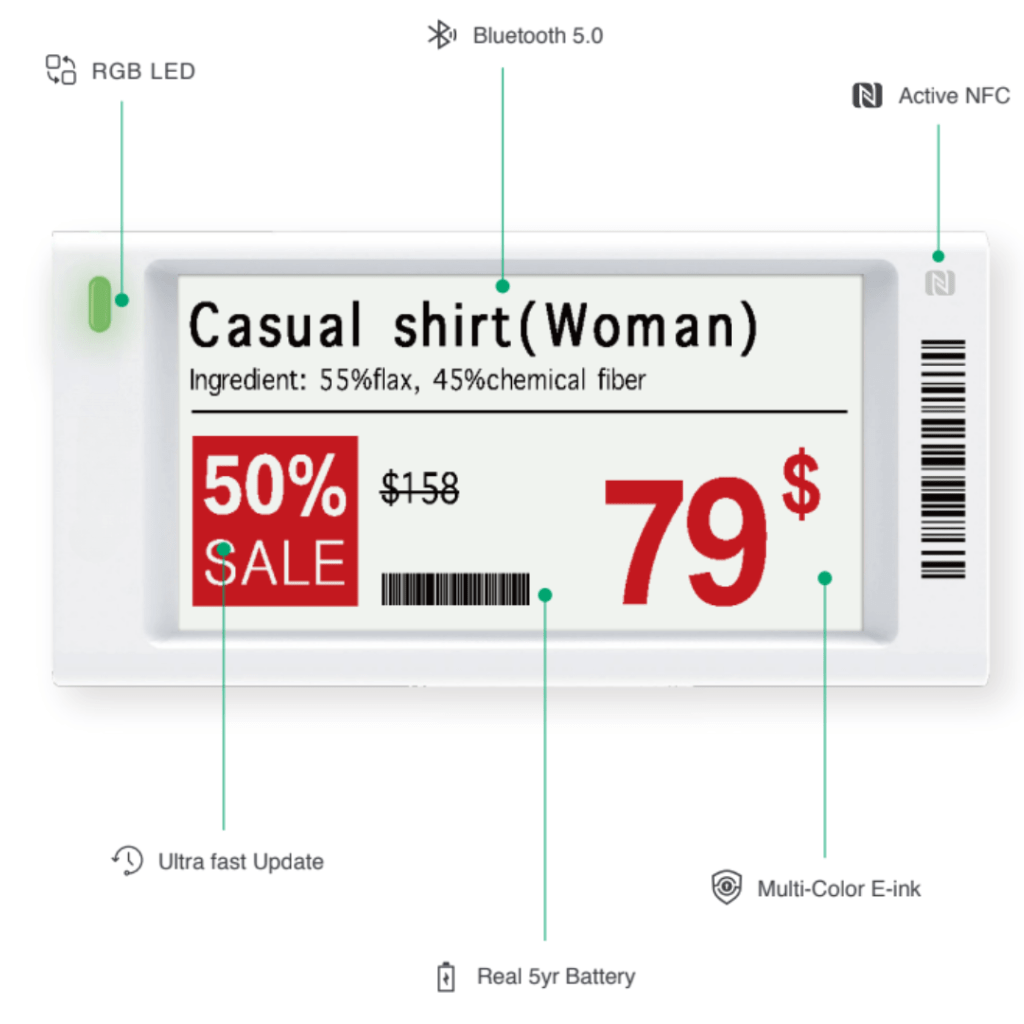ESL – Electronic Shelf Label
With the development of Internet technology and display technology, smart electronic shelf labels (ESL) are showing rapid growth. The system leverages E-ink electronic paper displays and ultra-low power wireless networking technology to provide retail-friendly electronic shelf label system solutions. Industry and help supermarkets to achieve paperless management, product information management, fine inventory management, product batch and period management to help customers save a lot of labor costs, expired goods and other costs, increase sales, while improving the overall level of retail information technology.

Bricor, being an industry leader in the POS space has partnered with a renowned cloud technology innovator to bring a unique ESL system to the Australian Market. A plug-and-play solution, inclusive of integration with your POS system will see your automated ticketing system up and running in no time!
Electronic Shelf Labels for Retail Market is also divided into applications and can be used in different industries and sectors. This segmentation highlights the main demand drivers, new applications and potential areas for market expansion. By analysing the usage patterns in different industries, Bricor identified the main areas of application that should contribute to growth, as well as the challenges and opportunities specific to each sector. For example, the development of certain applications may be motivated by technological advances or legislative changes, which gives companies a clear way to adapt their strategies to market needs.

1. Grocery Retailers
This segment focuses on the use of Digital Electronic Shelf Labels (ESLs) in grocery stores and supermarkets. ESLs in this sector are used for real-time price updates, promotions, and stock information. They improve the shopping experience by displaying accurate pricing and discounts, while reducing labor costs associated with manual label changes.
2. Clothing and Apparel Stores
In the clothing and apparel sector, ESLs enhance inventory management and provide dynamic pricing for seasonal promotions and fashion trends. These labels can also display detailed product information, such as size availability, fabric type, and color, helping customers make informed purchasing decisions.
3. Electronics Retailers
The electronics retail segment benefits from ESLs by displaying product specifications, prices, and discount offers. This helps in managing high volumes of products with frequent price changes and ensures that customers have easy access to the most up-to-date information about products like gadgets, home appliances, and accessories.
4. Pharmacies and Drugstores
Electronic Shelf Labels in pharmacies and drugstores display medication prices, discounts, expiration dates, and other important details. They improve operational efficiency by updating pricing in real time, and they help customers find relevant product information quickly, contributing to a smoother shopping experience.
5. Home Improvement and DIY Stores
In the home improvement and DIY segment, ESLs are used to manage a wide variety of tools, building materials, and home accessories. These labels help display real-time pricing, promotions, and product details, especially for large and complex product categories, while streamlining the retail environment and minimizing errors from manual price changes.

The Advantages of Bricor’s ESL System include:
- Real-time price updates (at the click of a button or tap of a finger)
- Reduction in labour cost
- Sustainability – Battery life of 5-10 years (subject to product type)
- Scalability – Our cloud-based system can support unlimited accounts/stores
- Plug and play – No installation required
- Minimal Hardware and Software requirements
- Infinite Server expansion
- Flexible Deployment (Multiple Server Options)
- Highly customisable – Design your price label display or select an existing template
- Highly compatible (Supports 200+ POS Systems)
- Data Security – AES 128-bit encryption technology
Frequently Asked Questions (FAQs) on Digital Electronic Shelf Labels for Retail Market
Digital electronic shelf labels are small digital displays that are used in retail stores to show product pricing and information. They can be updated remotely and provide real-time pricing information to customers.
The digital electronic shelf labels market is currently estimated to be worth $XXX million and is expected to grow at a CAGR of X% over the next five years.
The key drivers for the growth of the digital electronic shelf labels market include the increasing adoption of automation in retail, the need for accurate and real-time pricing information, and the growing trend of digital transformation in the retail sector.
The major challenges facing the digital electronic shelf labels market include the high initial implementation costs, the integration with existing retail infrastructure, and the potential resistance from traditional retailers.
The different types of digital electronic shelf labels include LCD labels, e-paper labels, and full-graphic labels with color displays.
The key applications of digital electronic shelf labels in retail include pricing management, inventory management, promotion management, and improving the overall customer experience.
The adoption rate of digital electronic shelf labels varies by region, with North America and Europe leading in adoption due to the presence of large retail chains and early adoption of technology.
Digital electronic shelf labels help improve operational efficiency in retail by reducing manual price changes, minimizing pricing errors, and enabling real-time updates across multiple stores.
The trends shaping the digital electronic shelf labels market include the integration of IoT and AI for real-time pricing, the adoption of cloud-based solutions for label management, and the development of energy-efficient display technologies.
The security considerations for digital electronic shelf labels in retail include data encryption, secure remote access, and protection against cyber threats to prevent unauthorized price changes.
The COVID-19 pandemic has accelerated the adoption of digital electronic shelf labels as retailers look for contactless and efficient solutions for pricing and inventory management.
Digital electronic shelf labels contribute to sustainability in retail by reducing paper waste from traditional paper labels and enabling energy-efficient display technologies.
The factors influencing the pricing of digital electronic shelf labels include the type of display technology, the size and resolution of the labels, and the software features for remote management.
The potential growth opportunities in the digital electronic shelf labels market include expansion into emerging markets, partnerships with retail technology providers, and the development of advanced features for customer engagement.
The regulatory considerations for implementing digital electronic shelf labels in retail include compliance with local pricing regulations, data privacy laws, and technical standards for electronic displays.
Digital electronic shelf labels improve customer experience in retail by providing accurate and up-to-date pricing information, enabling interactive product displays, and supporting personalized promotions.
The key technical requirements for implementing digital electronic shelf labels include wireless connectivity, compatibility with existing POS systems, and a user-friendly software interface for label management.
The competitive landscape in the digital electronic shelf labels market is characterized by the presence of both established players and new entrants offering innovative solutions for retail pricing and merchandising.
The future projections for the digital electronic shelf labels market indicate continued growth driven by the need for efficient retail operations, advancements in display technology, and the increasing adoption of digital retail strategies.
Contact us today if you require more information or click here to download our ESL Catalogue.

